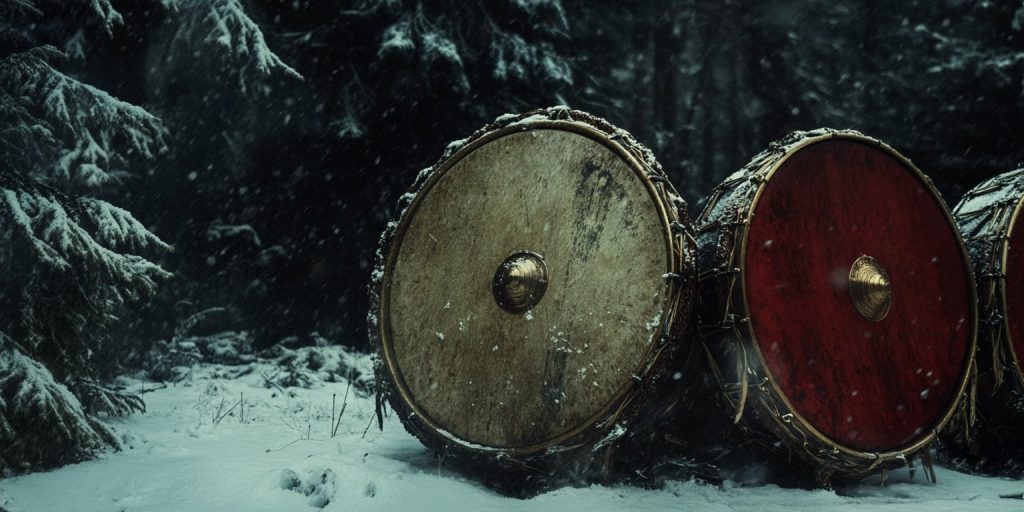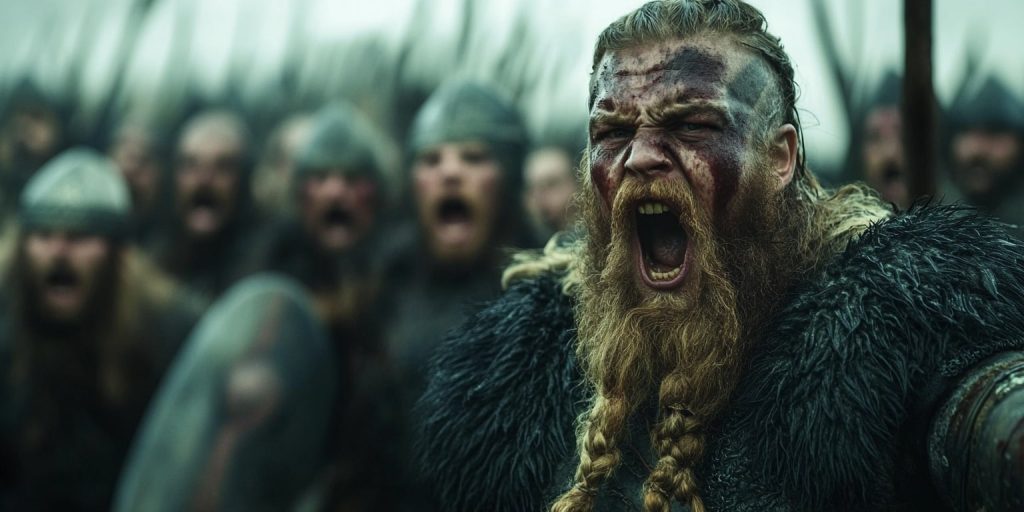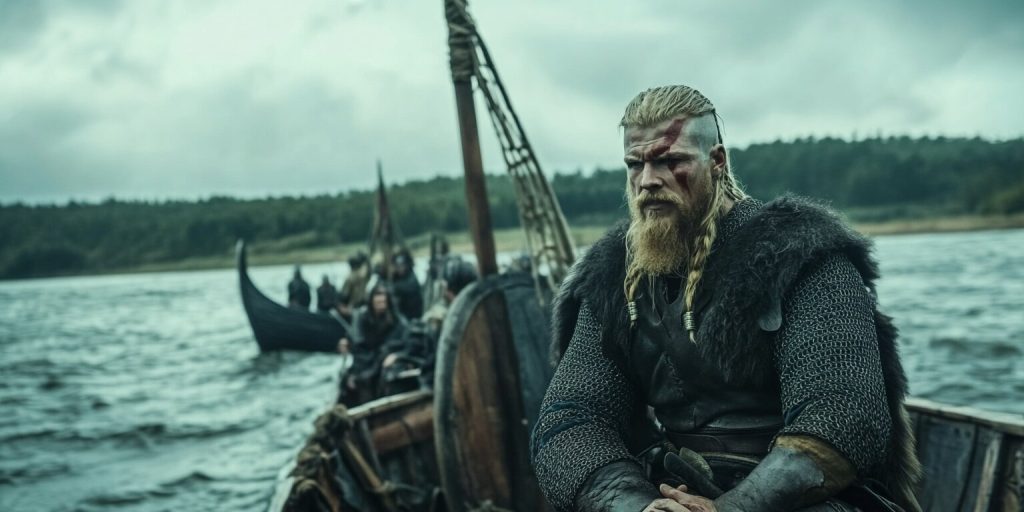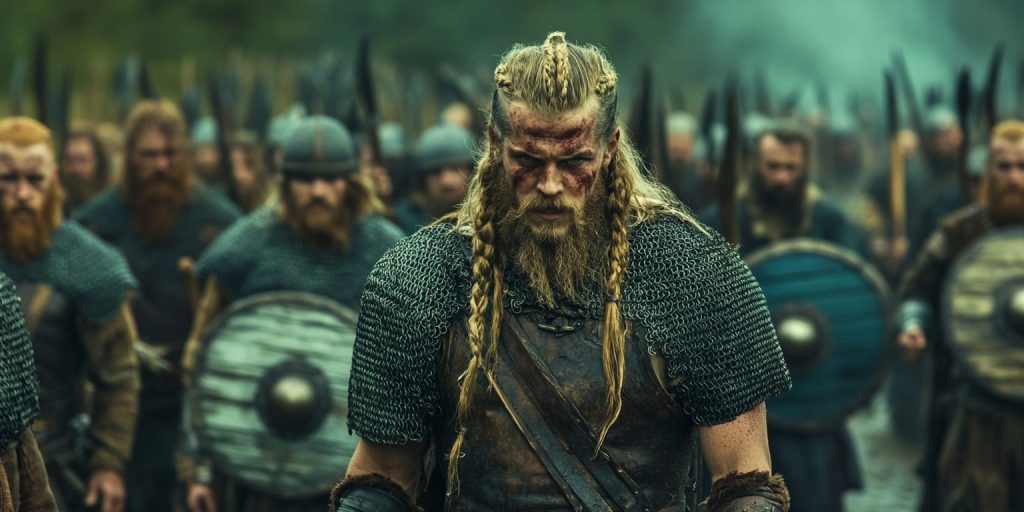Viking Heritage, Viking Raids and Warfare, Vikings
Viking War Songs: Myth & Truth
The world of Viking war songs is full of history and culture. These songs were key in the life of Norse warriors. They were not just battle cries but also told stories of the Vikings’ adventures and beliefs.
These songs have deep roots in the Viking Age. They mix music, tradition, and community identity. Exploring their origins and meanings helps us better understand Viking culture. It also shows how they’ve shaped our view of their legacy today.
The Significance of Viking War Songs in Culture
Viking war songs were a big part of their culture. They showed how music and battle were connected. These songs were more than just music. They were a key part of being a warrior.
Every note and lyric brought warriors together. It made them feel united as if they were all in this together. It made them strong and ready for battle.
Connecting Music to Battle
Warriors listened to songs before fighting. These songs made them feel brave and ready and told stories of heroes and great battles.
This music was key to building pride and courage. It helped Vikings see themselves as a strong group and feel ready to face their enemies.
The Role of Songs in Viking Society
Songs were very important in Viking culture. They were sung at gatherings and celebrations, celebrating victories and teaching the young about their history.
War songs were more than just fun music. They showed what being a Viking was all about in the context of aggressive Viking battles. They talked about winning battles and honoring those who had fallen in epic Viking confrontations. This kept the Vikings connected to their heritage.
Understanding Viking War Drums and Their Importance
Viking war drums were key tools that affected warriors and the battle mood. Making these drums required special skills and knowledge of materials. By looking at their strength and sound, we can see the effort put into making these vital war tools.

Crafting the Drum: Materials and Techniques
Making Viking war drums started with picking the right materials. This made the process both beautiful and useful. Craftsmen used:
- Animal skins, usually from deer or goats, were used for the drumhead in Nordic war music
- Wood from strong trees for a solid build
- Natural dyes to make the drums look good
They dried and tuned the skins for the best sound. This skill is seen in old Viking artifacts. It shows how skilled the Viking craftsmen were.
Drumming Patterns and Their Impact on Warriors
The beat of Viking war drums greatly affected warriors’ minds. Drumming created a rhythm that made warriors feel united and strong. Certain beats would go through the troops in battles, making them feel brave and fierce. Some common patterns were:
- Steady beats to keep the battle pace
- Strong rhythms for important battle moments, like charging
- Beats with gaps to add excitement and a sense of urgency
These drumming patterns were key in setting the warriors’ feelings. They helped warriors face challenges with courage and will.
Viking War Chants: An Exploration
In battle, warriors used their voices to scare and unite. Viking war chants were sung together. They prepared warriors for battle and scared the enemy with their powerful battle cries. These chants were a big part of Viking culture and helped in war.
The Power of Vocalization in Warfare
Viking chants were more than just songs. They were battle cries that made warriors feel strong and united. These chants matched the warriors’ moves, showing their bravery and will to fight.
When the battle was loud, these aggressive Viking chants helped warriors feel brave and strong and were key to winning fights.
Examples of Notable Viking War Chants
Many Viking chants show how important they were. They talked about bravery, honor, and fate. Here are some examples:
- Olaf’s Battle Cry: This chant asked for the gods’ help and made warriors more confident.
- The Berserkers’ Roar: This chant made warriors very brave and fierce.
- Fate’s Call: This chant accepted fate and made warriors determined.
Studying these chants shows how they shaped Viking warriors. They motivated warriors and reminded them of their duty and heritage. This shows how important the voice was in Viking warfare.
Viking War Songs: Myth & Truth
Studying Viking war songs shows us a mix of myth and truth. We look at historical sources to understand this mix. Scholars find out what’s real and what’s not by reading old texts.

Differentiating Fact from Fiction
Many stories about Viking war songs have turned into legends. These legends shape what we think about this epic Viking culture. Some songs were thought to make warriors brave and strong.
But old texts give us a more detailed view. They show that people saw the music in different ways based on their culture. We need to be careful to know what’s real and what’s not in these songs.
Historical Sources of Viking Music
The Poetic Edda and sagas are key sources for Viking music. They tell us about music’s importance in Viking battles and the valor of warriors. These texts also discuss the songs’ melodies and words.
They also show how music helped shape Viking identity and community life. By understanding these sources, we can better see the historical background of Viking war music.
Modern Interpretations and Their Impact
Today’s Viking music takes inspiration from the past but adds new twists. Artists bring old songs into the present with a modern touch. This mix of old and new is important for how we see these songs now.
Today, we can enjoy these ancient tunes and learn about their lasting impact, allowing us to connect with the past in a new way.
Popular Viking War Music Artists
Viking music has changed a lot over time, and many talented artists have helped shape it. Danheim is one artist who blends old Nordic sounds with new styles. Their music brings Viking war songs to life, making them a favorite among fans.
Spotlight on Danheim and Their Contributions
Danheim is known for its deep Viking soundscapes. Its haunting vocals, strong drums, and traditional instruments create powerful Viking music that feels like ancient battles and rituals.
Tracks like “Skald” and “Valhalla” show off the genre’s power. They also attract modern listeners.
Obtaining Viking Music: Streaming Platforms and Channels
It’s easy to find Viking music online. Spotify has playlists for Danheim and other artists. YouTube channels also offer a lot of Nordic folk music. These are great for fans and those new to the genre.
The Influence of Viking War Music Today
Viking war music has a big impact on today’s media. It’s found in movies and games, making stories more exciting. This music brings the world of Norse culture and history to life.
Filmmakers and game developers love using powerful Viking songs in their projects. They add depth and emotion to stories, making them feel more real and touching.
How Modern Media Portrays Viking Songs

Viking music mixes history with new ideas today, revealing these songs’ deep feelings and power. Shows like “Vikings” use music to intensify battle scenes.
This makes viewers feel like they’re part of the action. Documentaries and series also share the traditions of Viking music. They connect the past with today’s world through the lens of powerful Viking history.
Viking Music in Pop Culture and Video Games
Viking music is big in pop culture, especially in video games. Games like “Assassin’s Creed Valhalla” and “God of War” use music inspired by Vikings. These soundtracks make games more exciting and teach players about Norse culture through epic Viking narratives.
This has sparked a new interest in Viking history. Fans want to learn more about the stories behind the games.
Conclusion
Viking war songs are more than old tunes; they are powerful Viking anthems. They are key parts of Viking culture, showing a deep link between music and culture. They gave warriors courage and helped tell stories, keeping the Viking legacy alive.
Today, these songs still inspire musicians and fans. They show the spirit of the Vikings. These songs were for battle and showed what the Vikings valued.
Looking back, we see how these songs connected the past and present. They keep the Viking culture alive and make us appreciate their music. These songs invite us to learn more about a remarkable civilization.

